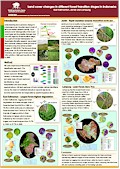| Poster |
 |
|
| Title | Land cover changes in different forest transition stages in Indonesia: East Kalimantan, Jambi and Lampung | | Author | Andree Ekadinata, Sonya Dewi and Dudy Kurnia Nugroho Adi | | Year | 2008 | | Publisher | World Agroforestry Centre - ICRAF, SEA Regional Office | | City | Bogor, Indonesia | | Call Number | PO0142-08 | | Keywords | forest transition, remote sensing, object based classification, deforestation, degradation, land use/cover, land use/cover changes |
|
| Abstract: |
| Understanding land use/cover change in a landscape is an important step in most of land use related research activity. Such analysis covered heterogeneity of land use/cover types and its possible changes over time with regards to forest transition stages.
We conduct land use/cover change in three provinces of Indonesia, East Kalimantan, Jambi, and Lampung using time series Landsat images of 1990-2005. The three provinces jointly covered 16.2 % of land area of Indonesia, and ranged in forest cover from 14% to 85% in 1990 and from 8% to 79% in 2005. Object-based hierarchical classification approach was used to produce time series land cover maps. The classification hierarchy consists of 4 levels: (i) land use/cover distinguishable visually, i.e., forested area, cloud, shadow, and water body; (ii) land use/cover that identifiable by visual interpretation and some simple spectral indices; (iii) Land use/cover of more complex natures that is only recognizable by means of statistical analysis on spectral signatures; (iv) land use/cover that are inseparable by spectral signature alone and needs some decision rules on spatial parameters based on expert knowledge (i.e. distance to road/ settlement, existence of logging trails).
Results of land cover classification showed different spatio-temporal patterns in the three Indonesian provinces. In East Kalimantan, logging and forest degradation dominates the land use/cover changes. Although still dominating the landscape, forested area decreased from 89.5% (162232 sq.km) in 1990 to 79.4% (147226. sq.km) in 2005. The area of undisturbed forest (including swamp forest and mangrove) decreased sharply from 73.8% (136321 sq.km) in 1990, 59.2% (108670 sq.km) in 2000, to 51.7% (94746 sq.km) in 2005. The intensity of logging activity in East Kalimantan is high, which is clearly indicated by the increase in logged over forest area from 13.7% (25911 sq.km) in 1990, 23.1% (43731 sq.km) in 2000, to 27.7% (52479 sq.km) in 2005.
Jambi province is currently undergoing a rapid transition toward a much intensified landscape. Forested area in 2005 covered 34% (16901 sq.km) of the province, down from 54% (25905 sq.km) in 1990. The single most dominant trend in Jambi is conversion to plantation, in this case rubber and oilpalm. Today, rubber area (agroforest and monoculture) in Jambi is larger than forested area; it is increased from 28% (13391.54 sq.km) in 1990 to 32% (15434.68 sq.km) in 2005. Oilpalm plantation also increased sharply from only 3% (1369.12 sq.km) in 1990 to more than 11% (5172 sq.km) in 2005.
Compared to East Kalimantan and Jambi, Lampung has the lowest forest cover, i.e., only 8% (2535 sq.km) of total forest cover in 2005, down from 14% (4525 sq.km) in 1990. The most dominant land cover type in Lampung today is coffee cultivation and oilpalm plantation. Land cover change analysis showed that the trend of coffee cultivation in Lampung is moving toward agroforestry system. This is indicated by the increase in coffee agroforest area from 13% (4259 sq.km) in 1990 to 16% (5169sq.km) in 2005, and, on the other hand, the decrease in monoculture coffee area from 14% (4533 sq.km) in 1990 to 12% (3782 sq. km) in 2005.
The three provinces represent different stages of forest transition in Indonesia, East Kalimantan being in the earliest stage a
nd Lampung the latest. Main drivers, spatial patterns and trends of land use and land use changes in other provinces in Indonesia are expected to be similar to the spatio-temporal pattern we observe in this study, with some variation which are due to site-specific demographic, cultural, biophysical and political context. Without any intervention and/or shock, progression in the forest transition over time is bound to happen, following the existing pattern. |
|